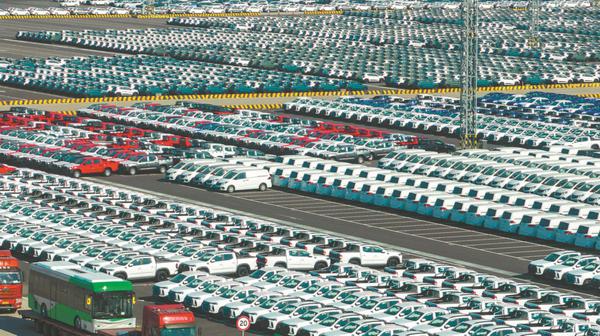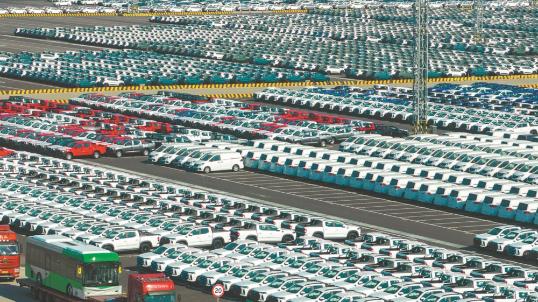Exports behind growth of car sales

Vehicles are lined up for export in the Haitong International Automotive Terminal in Taicang Port, Jiangsu province. (JI HAIXIN/FOR CHINA DAILY)
Except for a relatively sluggish commercial vehicle market, China's total automobile sales, new energy vehicle production and sales, and automobile exports all exceeded prior expectations in 2024, said the China Association of Automobile Manufacturers on Monday.
Last year, the country achieved cumulative automobile production and sales of 31.28 million and 31.44 million units, up 3.7 percent and 4.5 percent year-on-year, respectively, setting records and surpassing the previously set full-year sales target, CAAM said during its latest monthly information release conference.
The reading also marks the 16th consecutive year that the nation has maintained annual production and sales volumes exceeding 30 million units, securing its position as the world's largest automobile market.
"Exports have been the key driver behind the growth in production and sales data for 2024," said Xu Haidong, deputy secretary-general of CAAM.
According to the association, automobile sales increased by 1.34 million units last year compared to 2023, of which exports accounted for 949,000 units, making up a substantial 70.7 percent of the growth.
Xu added that despite the complex international landscape and emerging challenges facing China's auto exports, the sector maintained healthy growth trajectory, with exports surging from around 3 million units in 2022 to over 4 million in 2023 and nearly 6 million in 2024.
"While export volume continues to rise, the growth rate still reached nearly 20 percent last year, which is an encouraging trend," he said.
According to CAAM data, China's total automobile exports stood at 5.86 million units in 2024, a year-on-year increase of 19.3 percent. A closer look shows that traditional fuel vehicle exports rose by 23.5 percent to 4.57 million units, while NEV exports grew by 6.7 percent to 1.284 million units.
On the domestic front, NEVs are steadily capturing market share. CAAM's latest data revealed that NEV production and sales reached 12.89 million and 12.87 million units in 2024, up 34.4 percent and 35.5 percent year-on-year, respectively. Both record highs also highlight the fact that the country's NEV production and sales have topped global rankings for the 10th consecutive year.
"The old-for-new vehicle trade-in program, along with flexible and varied local initiatives to stimulate consumption, have provided a strong push to NEV sales," said Chen Shihua, deputy secretary-general of CAAM. "NEV sales have now accounted for over 50 percent of total passenger vehicle sales in the domestic market for seven consecutive months."
The transition toward intelligent electric vehicles has opened new avenues for Chinese brands to strengthen their market presence. In 2024, sales of Chinese-brand passenger vehicles reached 17.97 million units, up 23.1 percent year-on-year, with the current market share of domestic players reaching a record high of 65.2 percent, a rise of 9.2 percentage points, CAAM data showed.
Building on this momentum, a slew of Chinese automakers recently announced their NEV sales targets for the year ahead. Geely Auto has set a target of 2.71 million units for 2025, a year-on-year increase of 25 percent, with NEV sales expected to reach 1.5 million units, up 69 percent.
Zeekr, which saw exceptional performance in late 2024 with total deliveries of 222,123 units last year (up 87.15 percent year-on-year), has set a delivery target of 320,000 units for this year, marking a 44.06 percent increase.
Lei Jun, founder and CEO of Xiaomi, also unveiled the tech heavyweight's 2025 target: "Our goal is to deliver 300,000 vehicles in 2025."
Against the backdrop of the rapid rise of domestic brands, global automakers need to adjust their strategies, organizational structures and approaches according to the China market, said Gong Min, head of automotive industry research at financial services provider UBS China.

